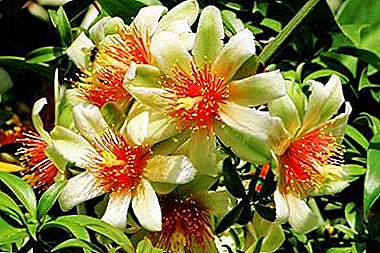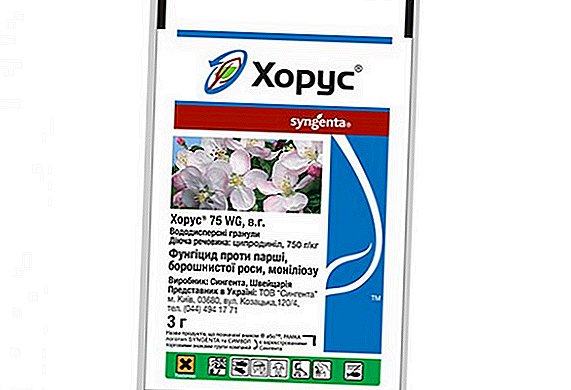
Pereskiya - ancient cactus with foliage
He can surprise many with his appearance, but this is what makes him unique.
General description of the plant
Outwardly, leaf cactus "Pereskiya" is not similar to the usual, in our view, cactus. But it really is. It belongs to the most ancient plants. The homeland of this unusual cactus is South America. In the process of evolution, adapting to the arid climate, spines appeared on cacti.
Interesting! Pereskiya cactus differs from its counterparts by the presence of leaves.
In nature, there are about 20 species. Some species of wild cacti produce edible fruits and grow from 5 to 10 m.
Views from the photo
Pereskiya grows very quickly. In the year it can grow by 20-25 cm. It is mainly found in the form of large shrubs, short trees with thorny, curly stems.
"Thorny"
This cactus is known by another name - “Suriname Gooseberry”, thanks to its edible fruits, growing up to 2.5 cm. In South America, this cactus is used as a hedge. This strong branching vine sometimes grows to 10 m. It has a fleshy stem, which is about 2 cm in diameter.
And still dark green leaves of oval shape are 9-10 cm long and 4-5 cm wide. As the lower leaves grow, the stem leaves, leaving the stem with long and hard spines. Flowers, yellow-white with a pinkish tinge, bloom on young shoots in late August. Flowers have a sweetish aroma, reaching a diameter of 5 cm.
The photo shows "Pereskiya Thorny" with proper care at home:
Godseff
It grows up to 2 m. She has a thin, erect stem, having long spines of black color. The leaves are narrow, elliptical in shape. The upper part of the leaf is golden-green in color, and from the bottom it is red or purple. The flowers are white, small, reminiscent of wild rose flowers.
The photo shows "Godseff Pereskiya" with proper care at home:

"Bolshetsvetkovaya"
In the wild, it reaches a height of 5 m, with a trunk diameter of 20 cm. Leaves are leathery, about 25 cm long, fall in winter when the thermometer mark is lower than 10. There are at least 90 spikes on the trunk, reaching 4 cm. The flowers are pinkish and gathered into inflorescences.
The photo shows “Pereskiya Bolshvetkovaya” with proper care at home:

Orange (Bleo)
It blooms in the summer months. She has bright orange-red flowers, about 5 cm in diameter, resembling a rose, opening in the evening. Forms bright yellow fruit, smell like pineapple, but inedible. It grows up to 5 m and has large leaves.
The photo shows "Pereskiya Orange" with proper care at home:

Home care
At home, the ancient cactus grows quite quickly. He does not need special care. There are several rules for keeping leafy cactus.
Lighting
 This light-loving plantBut you need to avoid the scorching sun. In the summer months there is a window on which stands Pereskiya, shade grid.
This light-loving plantBut you need to avoid the scorching sun. In the summer months there is a window on which stands Pereskiya, shade grid.
The best place for this cactus is the southern windows, especially in winter.
Due to the lack of lighting, the stem is pulled out, and the leaves become small and dull.
Recently bought flowers can not be immediately put on the window sill, exposing the sun. To the sun's rays need to be taught gradually.
Temperature
In the summer months the temperature should be no more than 27 degrees. In winter, in the dormant period - 10-15 degrees. The room must be aired, the cactus loves fresh air.
Air humidity
Humidity does not affect the development of the ancient cactus. Even during the heating season, when the air in the apartment is especially dry, the flower feels good. Spraying leaves should be carried out exclusively to remove dust. And for the prevention of pests.
Watering
Watering is carried out no earlier than the ground in a pot dries. You need to water with soft water, separated by at least a day. Abundant watering the plant requires a period of intensive growth.
Fertilizer
In winter, fertilize the flower is not necessary. And in the remaining months for fertilizer need to use special fertilizer mixtures for cacti. The dosage is applied two times less than that described in the instructions. Fertilizers are made monthly at the root. Organic fertilizer is undesirable.
Transfer
 Replanting adult plants is not recommended more than 1 time in 2-3 years.
Replanting adult plants is not recommended more than 1 time in 2-3 years.
Youngsters pass as they grow up.
Adults roll over when the root system fills the entire pot.
For transplantation, you can use the prepared soil, and you can prepare yourself.
Take 2 parts of leaf, sod land and humus, add 1 part of sand. For transplanting you need to take large pots. Put drainage on the bottom of the pot, then use the prepared soil mixture. After transplanting a cactus into a new pot, enhanced growth begins.
Breeding
The ancient cactus propagates by means of seeds or ripened cuttings. For rooting, you can use water. Put the cutting in a glass with water and periodically replace it.
Or you can use the earth mixture, as when transplanting, but with a small amount of charcoal. The earth should be constantly wet. The most suitable temperature is 26 degrees.
Diseases and pests
If a cobweb appears on the bottom of the sheet, and from above you can see small dots, which means that a spider mite has appeared. The leaves will begin to lose their color, will become pale yellow.
Points on the surface are formed by sucking the juice with tongs. Gradually, these points grow in size, forming large whitish-colored spots, which can lead to dropping leaves.
Spider mite infects the plant with dry air. Therefore, in the measures of prevention should periodically moisten the air. You also need to remove fallen leaves, periodically wash the leaves from dust.
First of all, when a spider mite infects, the plant needs to be treated with a soap solution, having previously covered the ground. If the defeat was extensive, then you need to use chemicals.
 Another pest is the cacti shieldfish.
Another pest is the cacti shieldfish.
It can be orange or pale yellow with a rounded shield, about 2 mm.
They mainly affect the upper side of the leaf.
After damage, yellow spots appear on the leaves.
After some time, the leaves fall off.
The first step is to use a soft cloth or cotton dipped in soapy water to process the leaves and stem of the plant. You can use a soap-alcohol mixture: 30 g of liquid soap, 20 ml of alcohol mixed in 2 liters of warm water. In case of severe damage, you need to use chemicals.
The most dangerous pest is the mealybug. It is about 4 mm in size. The greatest accumulation can be observed on young shoots. Mealybug emit sticky liquid contaminating the plant. On the leaves appears spider patina, new shoots and leaves are deformed, flowers fall.
It is necessary to treat the plant with a soap or soap-alcohol solution. Then you need to sprinkle three times, with an interval of 1 week, garlic decoction or calendula tincture.
Also, the cause of the disease can be improper care. When overmoistening of the soil, the root system decays. The only way out is to plant the plant in a new land.
Attention! Before planting in a new pot you need to process the roots with charcoal.
When the soil dries out, the plant weakens, the leaves become sluggish and fall off over time.
Pereskiya Cactus is not only used for decorative purposes. It is used by experienced growers for grafting other types of cacti.
Having bought such an unusual cactus, it is worth remembering that he comes from antiquity. And with the right care, he will certainly become your pride among the potted flowers.












